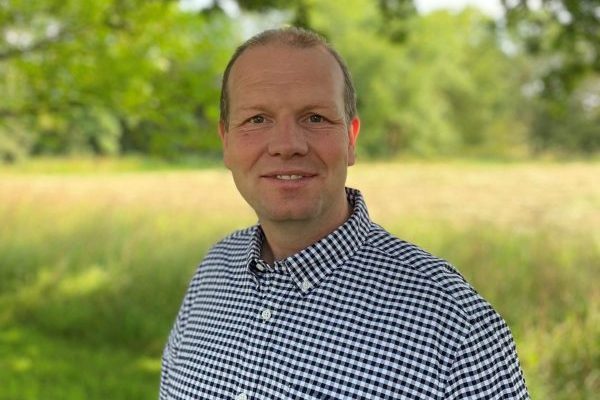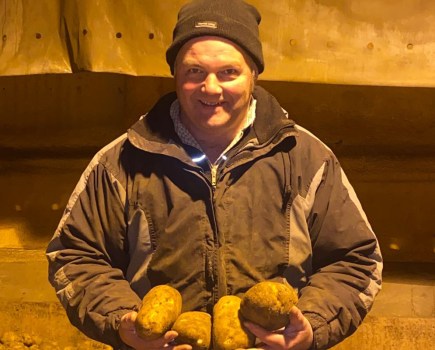By Martin Lines
It’s now 2050 – as I step outside the farmhouse door on a September morning, I think to myself what tremendous changes have taken place.
The first thing that hits me is the noise – swifts screech as they swirl above me and somewhere too high to see in the sun’s rays are skylarks and corn buntings. The swallows and other migratory birds join us for much longer during the summer now, others a rare sight as their territories have moved beyond my Cambridgeshire farm.
As I walk through the garden, insects buzz, click, and chirp, joining the cacophony. Birds-foot trefoils and red clovers buckle under the weight of newly emerged bumblebee queens.
I step into the fields beyond the garden, stop and stare. I notice the variety of trees in the landscape: our ash trees are gone due to disease. Other older trees are also dead, but trunks are left standing to provide homes for the beneficial insects that help to keep crop pests down now insecticide spraying is banned.
Thankfully, we used the SFI action of planting on-farm trees in 2025-40 which offer shade to crops and livestock, sequestering carbon and helping slow the flow of water from the warmer, wetter winters. They don’t take much to oversee – many of my hedges are managed by rotational coppicing for compost making.
I turn my attention to the ground. In the past 25 years it’s been a challenge to adapt and refine our approaches, but it would have been far greater if I hadn’t already started to make small changes such as spraying less and direct drilling.
Years ago we moved from using land to grow animal feed as the demand reduced dramatically, with people eating less white meat and choosing red meat that’s grazed the landscape using regenerative methods. As the UK government also banned crops grown for fuel or energy production, we now grow milling, biscuit and pasta wheats, as well as malting barley.
We stopped growing single varieties due to the increasing costs of license fees and genetics in breeding that prevent us from using home-saved seed. During the 2030s and 2040s, the unpredictable and extreme weather in autumn and winter – including higher rainfall, combined with having to reduce the risk of overhead costs – meant I transitioned to growing blends, which has greatly reduced the risk of disease.
I also have an army of minibeasts: beneficial insects such as lacewings, ground beetles, hoverflies, soldier beetles, and ladybirds, all thriving in the restored habitat we now provide. These predate the pests I used to spray for including aphids and pollen beetle, at no cost to myself. Plus many pollinate crops, helping to increase yields whereas 30 years ago, they didn’t have a home. Glyphosate was banned firstly for use on crops for the human food supply chain, and then as weed-resistance levels grew, it was banned for general use also.
I dig my hand into the earth, pulling out a chunk in my fist. It smells…almost of nothing, but also musty and appealing. It crumbles away between my fingers and I’m careful to not squash the worms. These days, we know a lot more about soil health, such as the importance of living roots in the soil, minimising disturbance and growing a diversity of plants, and we can act accordingly.
I walk past a small pond, shimmering with pond skaters and damselflies, and into a larger field. We used to grow oilseed rape here, but stopped due to the lack of moisture during establishing in our hotter autumns. We now grow soybeans and sunflowers as break crops.
In the autumn, we’ll terminate the catch crops that are in the ground. These days, they’re terminated mechanically and sometimes with the aid of livestock grazing. The move to mechanical weeding with robotics and AI means we only have to remove weeds to a competitive level, we don’t get rid of everything.
It’s not just weeding that’s automated. In addition to the birdsong and percussive rhythms of beneficial insects, I can hear the faint hum of a drone, fading in and out. All field operations now use drones and driverless tractors which send data straight to the central data hub which we can access anytime.
Rather than synthetic inputs, we use biology and micronutrients to keep crops healthy. Carbon taxes on fossil fuel fertiliser meant we stopped using these, but as my soil health has been steadily improving, this hasn’t been as much of a problem as you might think.
The field I’m standing in used to be tied into ELM schemes — SFI and CS. I’d signed up for actions such as wildflower margins, birdseed mixes, and beetle mounds. I gradually saw the field, the soil, and the hedgerows come back to life, networked together in a patchwork of habitats, food, and shelter.
ELMs is a distant memory and all public money supports various landscape approaches for nature restoration and climate solutions. The financial returns from food production have greatly improved as the impact costs to climate and biodiversity and human health are increasingly recognised.
As I return towards the yard, I think back to 2024. I’d made quite a few changes to my farm practices then – spraying less, SFI actions, direct drilling – I was doing my best to prepare for the future. But others around me thought nature-friendly farming wouldn’t be enough to restore the land to its former fertility and to impact the resilience of the farm business.
It was scary for me to risk changing our long-established ways; some things I tried didn’t work, but I learned from these mistakes and was supported by others transitioning to more regenerative methods.
Today, I’m glad I prepared the farm for what was to come so the business can thrive in 40oC summers and warm, wet winters – where once it wouldn’t have. Farmers are now valued for more than just food production, because as custodians of 70% of UK land, we also nurture the spaces that provide ecosystem services for everyone. That’s something to be proud of.
This article was taken from the latest issue of CPM. For more articles like this, subscribe here.
Sign up for Crop Production Magazine’s FREE e-newsletter here.




